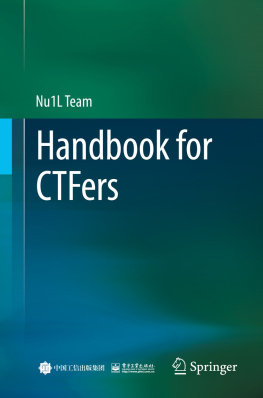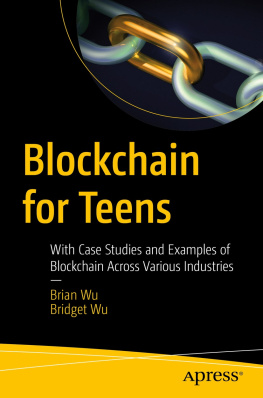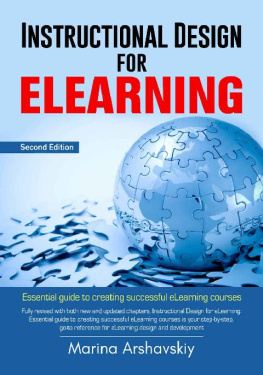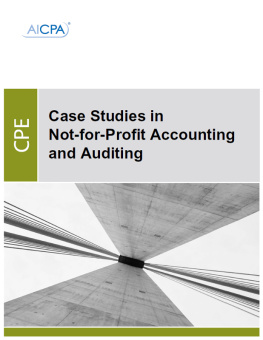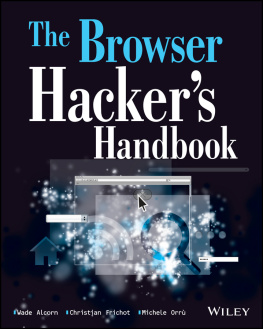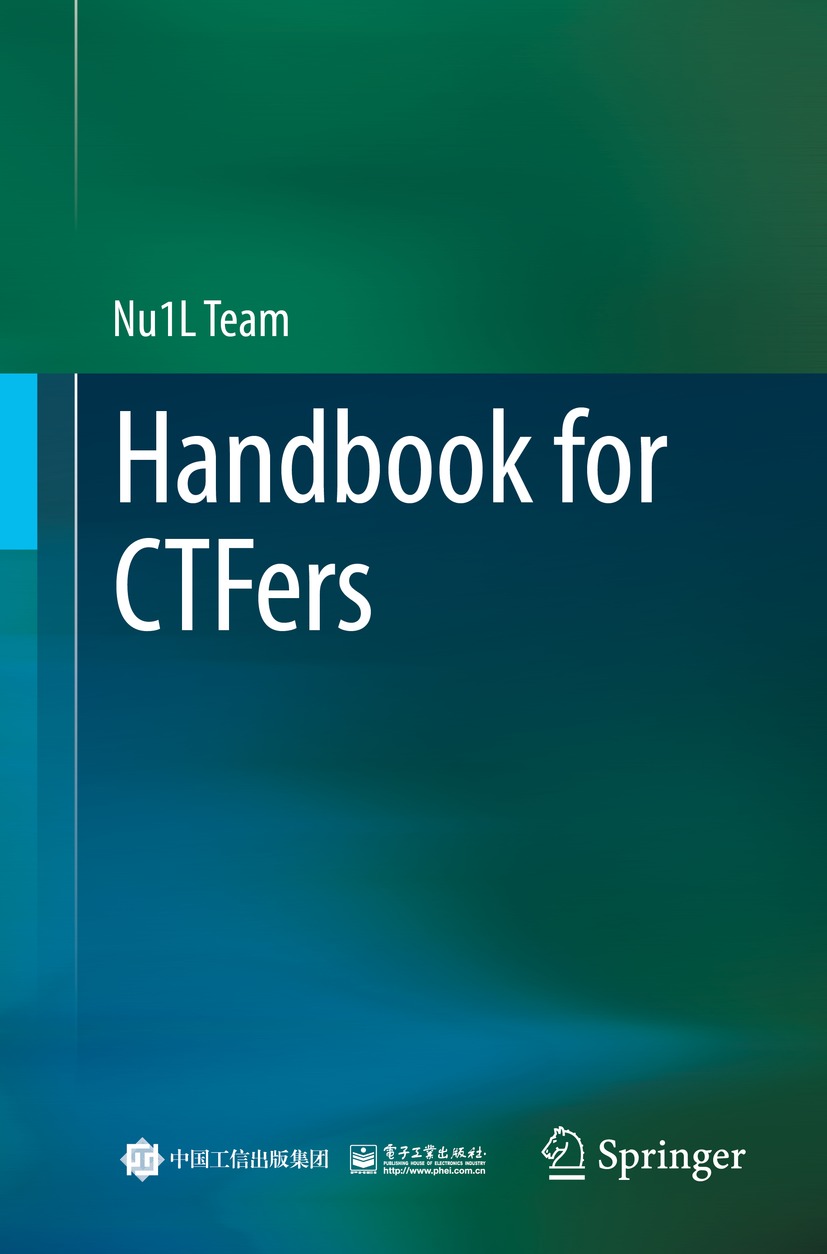Nu1L Team
Handbook for CTFers

Logo of the publisher

Logo of the publisher
Nu1L Team
Nu1L Team, Shanghai, China
ISBN 978-981-19-0335-9 e-ISBN 978-981-19-0336-6
https://doi.org/10.1007/978-981-19-0336-6
Jointly published with Publishing House of Electronics Industry
The print edition is not for sale in China (Mainland). Customers from China (Mainland) please order the print book from: Publishing House of Electronics Industry.
Jointly published with, Publishing House of Electronics Industry, Beijing, P.R.China
Publishing House of Electronics Industry 2022
This work is subject to copyright. All rights are solely and exclusively licensed by the Publisher, whether the whole or part of the material is concerned, specifically the rights of reprinting, reuse of illustrations, recitation, broadcasting, reproduction on microfilms or in any other physical way, and transmission or information storage and retrieval, electronic adaptation, computer software, or by similar or dissimilar methodology now known or hereafter developed.
The use of general descriptive names, registered names, trademarks, service marks, etc. in this publication does not imply, even in the absence of a specific statement, that such names are exempt from the relevant protective laws and regulations and therefore free for general use.
The publishers, the authors, and the editors are safe to assume that the advice and information in this book are believed to be true and accurate at the date of publication. Neither the publishers nor the authors or the editors give a warranty, express or implied, with respect to the material contained herein or for any errors or omissions that may have been made. The publishers remain neutral with regard to jurisdictional claims in published maps and institutional affiliations.
This Springer imprint is published by the registered company Springer Nature Singapore Pte Ltd.
The registered company address is: 152 Beach Road, #21-01/04 Gateway East, Singapore 189721, Singapore
Preface
In 2017, we had the idea of writing a book for CTF beginners, but the idea was put on hold because of the limited number of team members at the time. By the end of 2018, our team Nu1L had grown to nearly 40 members, and the idea of writing a book was rekindled. After asking many team members and reaching a consensus, we started writing the book.
After preliminary discussions, we decided to incorporate as many aspects of the CTF competition as possible, as we wanted the book to be a systematic textbook for CTF beginners. At the same time, in order to avoid the book becoming a system security fundamentals book that only lists professional knowledge, we also interspersed the problem-solving tricks and personal experiences to allow the reader to better integrate, in addition to a large number of CTF-related techniques.
The purpose of this book is to let more people enjoy CTF competitions, have a better understanding of CTF competitions, and then improve their own techniques through this book.
Structure of the Book
This book is divided into two parts: the online jeopardy-style CTF and CTF finals. In addition to the content related to CTF competitions, we also share some real-world vulnerability mining experiences with the readers.
The online jeopardy-style CTF part consists of ten chapters, covering Web, PWN, Reverse, APK, Misc, Crypto, blockchain, and code auditing. These chapters cover most of the CTF topic categories, with corresponding example challenges and solutions, which enable readers to fully understand and learn the corresponding techniques. At the same time, the content of this book can also be used as a reference during CTF competitions.
The CTF finals part consists of two chapters, namely AWD and penetration test. The AWD chapter provides an in-depth introduction to related tricks and flow analysis; the penetration chapter is closer to the real world, so readers can combine it with actual practice and gain something from it.
Description
As we all know, CTF involves a wide variety of professional knowledges, so 29 members of Nu1L team contributed to this book, and each person was responsible for writing different chapters. I have tried to standardize as much as possible before writing, but everyones writing style is not exactly the same, so some of the chapters differ greatly in writing style.
The Nu1L team members who contributed to this book are first-time writers, so there is no guarantee that this book will be exhaustive, but it will cover the appropriate aspects of CTF competition in as much detail as possible. This book is mainly for CTF beginners, and if written in detail, each part would be enough to fill a book, so we have also filtered the content of each part to cover the common techniques of CTF. For example, the SQL injection section in the Web chapter only covers injection scenarios under MySQL, but not under SQL Server, NoSQL, etc.
We hope the readers can understand us.
About the Nu1L Team
Nu1L is a CTF team founded in 2015, whose name is derived from the word NULL. Nu1L is one of the top CTF teams in China, with more than 70 members, and the official website is https://nu1l.com .
Nu1L has competed in a lot CTF competitions around the world with excellent results, such as,
DEFCON CHINA & BCTF2018 Champion
Ranked 1st locally, 4th globally in the 0CTF/TCTF 2018 Finals
Ranked 1st globally in the LCTF&SCTF for 3 years
2019 XCTF Finals Champion
Ranked 7th in the DEFCON CTF 2021 Finals
N1CTF( https://ctftime.org/ctf/240 ) International CTF Organizer
Some of the team members are speakers at Blackhat, HITCON, KCON, and other security conferences, and participate in professional hacking competitions such as PWN2OWN and GEEKPWN. Some of the core team members also work for Tea Deliverers and eee teams.
The Author(s), under exclusive license to Springer Nature Singapore Pte Ltd. 2022
Nu1L Team Handbook for CTFers https://doi.org/10.1007/978-981-19-0336-6_1
1. Introduction to the Web
Nu1L Team
(1)
Nu1L Team, Shanghai, China
Web challenges could be seen everywhere in traditional CTF competitions. They are easier to get started because they do not require in-depth knowledge of operating systems and complicated assembly instructions than PWN and Reverse challenges. On the other hand, they do not require strong programming skills compared to Crypto and MISC challenges.

